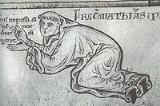
Matthew Paris
Encyclopedia
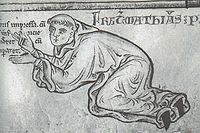
Benedictine
Benedictine refers to the spirituality and consecrated life in accordance with the Rule of St Benedict, written by Benedict of Nursia in the sixth century for the cenobitic communities he founded in central Italy. The most notable of these is Monte Cassino, the first monastery founded by Benedict...
monk, English chronicler
English historians in the Middle Ages
Historians of England in the Middle Ages helped to lay the groundwork for modern historical historiography, providing vital accounts of the early history of England, Wales and Normandy, its cultures, and revelations about the historians themselves....
, artist in illuminated manuscript
Illuminated manuscript
An illuminated manuscript is a manuscript in which the text is supplemented by the addition of decoration, such as decorated initials, borders and miniature illustrations...
s and cartographer, based at St Albans Abbey
St Albans Cathedral
St Albans Cathedral is a Church of England cathedral church at St Albans, England. At , its nave is the longest of any cathedral in England...
in Hertfordshire
Hertfordshire
Hertfordshire is a ceremonial and non-metropolitan county in the East region of England. The county town is Hertford.The county is one of the Home Counties and lies inland, bordered by Greater London , Buckinghamshire , Bedfordshire , Cambridgeshire and...
. He wrote a number of works, mostly historical, which he scribed and illuminated himself, typically in drawings partly coloured with watercolour washes, sometimes called "tinted drawings". Some were written in Latin, some in Anglo-Norman
Anglo-Norman
The Anglo-Normans were mainly the descendants of the Normans who ruled England following the Norman conquest by William the Conqueror in 1066. A small number of Normans were already settled in England prior to the conquest...
or French verse. His Chronica Majora
Chronica Majora
The Chronica Majora is an important medieval illuminated manuscript chronicle by Matthew Paris, one of a number of redactions of his work on English history.It is currently in Corpus Christi College, Cambridge. It covers the period 1240-53...
is an oft-cited source, though modern historians recognize that Paris was not always reliable. He tended to glorify Emperor Frederick II
Frederick II, Holy Roman Emperor
Frederick II , was one of the most powerful Holy Roman Emperors of the Middle Ages and head of the House of Hohenstaufen. His political and cultural ambitions, based in Sicily and stretching through Italy to Germany, and even to Jerusalem, were enormous...
and denigrate the Pope
Pope
The Pope is the Bishop of Rome, a position that makes him the leader of the worldwide Catholic Church . In the Catholic Church, the Pope is regarded as the successor of Saint Peter, the Apostle...
.
Life and work
In spite of his surname and knowledge of the French languageFrench language
French is a Romance language spoken as a first language in France, the Romandy region in Switzerland, Wallonia and Brussels in Belgium, Monaco, the regions of Quebec and Acadia in Canada, and by various communities elsewhere. Second-language speakers of French are distributed throughout many parts...
, Paris was of English birth, and is believed by some historians to be of the Paris family of Hildersham
Hildersham
Hildersham is a small village 8 miles to the south-east of Cambridge, England. It is situated just off the A1307 between Linton and Great Abington on a tributary of the River Cam known locally as the River Granta...
, Cambridgeshire
Cambridgeshire
Cambridgeshire is a county in England, bordering Lincolnshire to the north, Norfolk to the northeast, Suffolk to the east, Essex and Hertfordshire to the south, and Bedfordshire and Northamptonshire to the west...
. He may have studied at Paris
Paris
Paris is the capital and largest city in France, situated on the river Seine, in northern France, at the heart of the Île-de-France region...
in his youth after early education at the St Albans Abbey School
St Albans School (Hertfordshire)
St Albans School is an independent school in the city of St Albans in Hertfordshire, in the East of England. Entry before Sixth Form is for boys only, and co-educational thereafter. Founded in 948 by Wulsin , St Albans School is not only the oldest school in Hertfordshire but also one of the oldest...
. The first we know of Matthew Paris (from his own writings) is that he was admitted as a monk to St Albans in 1217. It is on the assumption that he was in his teens on admission that his birth date is estimated; some scholars suspect he may have been ten years or more older; many monks only entered monastic life after pursuing a career in the world outside. He was clearly at ease with the nobility and even royalty, which may indicate that he came from a family of some status, although it also seems an indication of his personality. His life was mainly spent in this religious house. In 1248, Paris was sent to Norway as the bearer of a message from Louis IX
Louis IX of France
Louis IX , commonly Saint Louis, was King of France from 1226 until his death. He was also styled Louis II, Count of Artois from 1226 to 1237. Born at Poissy, near Paris, he was an eighth-generation descendant of Hugh Capet, and thus a member of the House of Capet, and the son of Louis VIII and...
to Haakon IV
Haakon IV of Norway
Haakon Haakonarson , also called Haakon the Old, was king of Norway from 1217 to 1263. Under his rule, medieval Norway reached its peak....
; he made himself so agreeable to the Norwegian sovereign that he was invited to superintend the reformation of the Benedictine monastery of Nidarholm outside Trondheim
Trondheim
Trondheim , historically, Nidaros and Trondhjem, is a city and municipality in Sør-Trøndelag county, Norway. With a population of 173,486, it is the third most populous municipality and city in the country, although the fourth largest metropolitan area. It is the administrative centre of...
.
Apart from these missions, his known activities were devoted to the composition of history, a pursuit for which the monks of St Albans had long been famous. After admission to the order in 1217, he inherited the mantle of Roger of Wendover
Roger of Wendover
Roger of Wendover , probably a native of Wendover in Buckinghamshire, was an English chronicler of the 13th century.At an uncertain date he became a monk at St Albans Abbey; afterwards he was appointed prior of the cell of Belvoir, but he forfeited this dignity in the early years of Henry III,...
, the abbey's official recorder of events, in 1236. Paris revised Roger's work, and that of Abbot John de Cella
John of Wallingford
John of Wallingford , also known as John de Cella, was Abbot of St Albans Abbey in the English county of Hertfordshire from 1195 to his death in 1214...
, adding new material to cover his own tenure. This Chronica Majora
Chronica Majora
The Chronica Majora is an important medieval illuminated manuscript chronicle by Matthew Paris, one of a number of redactions of his work on English history.It is currently in Corpus Christi College, Cambridge. It covers the period 1240-53...
is an important historical source document, especially for the period between 1235 and 1259. Equally interesting are the illustrations Paris created for his work.
The Dublin MS (see below) contains interesting notes, which shed light on Paris's involvement in other manuscripts, and on the way his own were used. They are in French and in his handwriting:
- "If you please you can keep this book till Easter"
- "G, please send to the Lady Countess of Arundel, Isabel, that she is to send you the book about St Thomas the MartyrThomas BecketThomas Becket was Archbishop of Canterbury from 1162 until his murder in 1170. He is venerated as a saint and martyr by both the Roman Catholic Church and the Anglican Communion...
and St EdwardEdward the ConfessorEdward the Confessor also known as St. Edward the Confessor , son of Æthelred the Unready and Emma of Normandy, was one of the last Anglo-Saxon kings of England and is usually regarded as the last king of the House of Wessex, ruling from 1042 to 1066....
which I copied (translated?) and illustrated, and which the Lady Countess of Cornwall may keep until WhitsunWhitsunWhitsun is the name used in the UK for the Christian festival of Pentecost, the seventh Sunday after Easter, which commemorates the descent of the Holy Spirit upon Christ's disciples...
tide" - some verses
- "In the Countess of Winchester's book let there be a pair of images on each page thus": (verses follow describing thirteen saints)
- it is presumed the last relates to Paris acting as commissioning agent and iconographical consultant for the Countess with another artist.
The lending of his manuscripts to aristocratic households, apparently for periods of weeks or months at a time, suggests why he made several different illustrated versions of his Chronicle.
Manuscripts by Matthew Paris
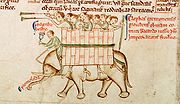
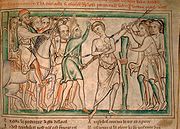

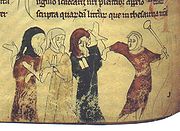
Dissolution of the Monasteries
The Dissolution of the Monasteries, sometimes referred to as the Suppression of the Monasteries, was the set of administrative and legal processes between 1536 and 1541 by which Henry VIII disbanded monasteries, priories, convents and friaries in England, Wales and Ireland; appropriated their...
. These MS seem to have been appreciated, and were quickly collected by bibliophiles.
- Chronica MajoraChronica MajoraThe Chronica Majora is an important medieval illuminated manuscript chronicle by Matthew Paris, one of a number of redactions of his work on English history.It is currently in Corpus Christi College, Cambridge. It covers the period 1240-53...
Corpus Christi College, CambridgeCorpus Christi College, CambridgeCorpus Christi College is a constituent college of the University of Cambridge. It is notable as the only college founded by Cambridge townspeople: it was established in 1352 by the Guilds of Corpus Christi and the Blessed Virgin Mary...
Ms 26, 16, 362 x 244/248 mm. ff 141 + 281, 1240-53. His major historical work (see below), but less heavily illustrated per page than others.http://parkerweb.stanford.edu/ The first two volumes are in Cambridge, whilst the third is bound with the Historia Anglorum in the British LibraryBritish LibraryThe British Library is the national library of the United Kingdom, and is the world's largest library in terms of total number of items. The library is a major research library, holding over 150 million items from every country in the world, in virtually all known languages and in many formats,...
volume below. There are 100 marginal drawings (25 + 75), some fragmentary maps and an itinerary, and full-page drawings of William IWilliam I of EnglandWilliam I , also known as William the Conqueror , was the first Norman King of England from Christmas 1066 until his death. He was also Duke of Normandy from 3 July 1035 until his death, under the name William II...
and the Elephant with Keeper. MS 16 has very recently had all prefatory matter removed in a rebinding. Most of the text of the Chronica in MS 26 is not in Paris's hand.
- Life of St AlbanSaint AlbanSaint Alban was the first British Christian martyr. Along with his fellow saints Julius and Aaron, Alban is one of three martyrs remembered from Roman Britain. Alban is listed in the Church of England calendar for 22 June and he continues to be venerated in the Anglican, Catholic, and Orthodox...
etc., dating controversial (1230-1250), Trinity College, Dublin Library, Ms E.I.40. 77 ff with 54 miniatures, mostly half-page. 240 x 165 mm. Also contains a Life of St AmphibalusAmphibalusSaint Amphibalus was formerly venerated as the Christian priest traditionally sheltered by Saint Alban, who was converted by him, as a consequence of which Alban was martyred....
, and various other works relating to the history of St Albans AbbeySt Albans CathedralSt Albans Cathedral is a Church of England cathedral church at St Albans, England. At , its nave is the longest of any cathedral in England...
, both also illustrated. The Life of St Alban is in French verse, adapted from a Latin source. The manuscript also contains notes in Paris's hand (see above) showing that his manuscripts were lent to various aristocratic ladies for periods, and that he probably acted as an intermediary between commissioners of manuscripts and the (probably) lay artists who produced them, advising on the calendars and iconography.
- Abbreviatio chronicorum (or Historia minor), another shortened history, mainly covering 1067 to 1253, including a Map of Great Britain, 1255-9 (probably his final work), British LibraryBritish LibraryThe British Library is the national library of the United Kingdom, and is the world's largest library in terms of total number of items. The library is a major research library, holding over 150 million items from every country in the world, in virtually all known languages and in many formats,...
Cotton MS Claudius D.vi. Illustrated with thirty-three seated figures of English kings' illustrating a genealogyGenealogyGenealogy is the study of families and the tracing of their lineages and history. Genealogists use oral traditions, historical records, genetic analysis, and other records to obtain information about a family and to demonstrate kinship and pedigrees of its members...
.
- Historia Anglorum 1250-9 British LibraryBritish LibraryThe British Library is the national library of the United Kingdom, and is the world's largest library in terms of total number of items. The library is a major research library, holding over 150 million items from every country in the world, in virtually all known languages and in many formats,...
MS Royal 14.C.VII, 358 x 250 mm, ff 232, also the last volume of the Chronica Majora, and various other items, including maps of the Holy Land and the British Isles, an itinerary from London to ApuliaApuliaApulia is a region in Southern Italy bordering the Adriatic Sea in the east, the Ionian Sea to the southeast, and the Strait of Òtranto and Gulf of Taranto in the south. Its most southern portion, known as Salento peninsula, forms a high heel on the "boot" of Italy. The region comprises , and...
, a full-page Virgin and Child with Matthew Paris kneeling before them (illustration above, his most monumental work), and a genealogy of the Kings of England with seated portraits. The Historia Anglorum has 32 marginal drawings, rather more sketchy than in the earlier volumes. There is a portrait of Paris on his death-bed, presumably not by him. By the 15th century this volume belonged to Humphrey, Duke of GloucesterHumphrey, Duke of GloucesterHumphrey of Lancaster, 1st Duke of Gloucester, 1st Earl of Pembroke, KG , also known as Humphrey Plantagenet, was "son, brother and uncle of kings", being the fourth and youngest son of king Henry IV of England by his first wife, Mary de Bohun, brother to king Henry V of England, and uncle to the...
, son of Henry IVHenry IV of EnglandHenry IV was King of England and Lord of Ireland . He was the ninth King of England of the House of Plantagenet and also asserted his grandfather's claim to the title King of France. He was born at Bolingbroke Castle in Lincolnshire, hence his other name, Henry Bolingbroke...
, who inscribed it "Ceste livre est a moy Homffrey Duc de Gloucestre". Later it was held by the bishop of LincolnBishop of LincolnThe Bishop of Lincoln is the Ordinary of the Church of England Diocese of Lincoln in the Province of Canterbury.The present diocese covers the county of Lincolnshire and the unitary authority areas of North Lincolnshire and North East Lincolnshire. The Bishop's seat is located in the Cathedral...
, who wrote a note that if the monks of St Albans could prove the book was a loan, they should have it back. Otherwise it was bequeathed to New College, OxfordNew College, OxfordNew College is one of the constituent colleges of the University of Oxford in the United Kingdom.- Overview :The College's official name, College of St Mary, is the same as that of the older Oriel College; hence, it has been referred to as the "New College of St Mary", and is now almost always...
. The fact that the book was acquired by a 16th-century Earl of Arundel suggests that Duke Humphrey's inscription was not entirely accurate, as New College would probably not have disposed of it.
- Book of Additions (Liber additamentorum) British LibraryBritish LibraryThe British Library is the national library of the United Kingdom, and is the world's largest library in terms of total number of items. The library is a major research library, holding over 150 million items from every country in the world, in virtually all known languages and in many formats,...
Cotton MS Nero D I, ff202 in all, contains maps, Vitae duorum OffarumVitae duorum OffarumThe Vitae duorum Offarum "The lives of the two Offas" is a literary history written in the mid-thirteenth century, apparently by the St Albans monk Matthew Paris.-Account:...
(illustrated), Gesta abbatum, the lives of the first 23 abbots of St Albans with a miniature portrait of each, coats of arms, as well as copies of original documents. A version of his well-known drawing of an elephant is in this volume, as is a large drawing of ChristChristChrist is the English term for the Greek meaning "the anointed one". It is a translation of the Hebrew , usually transliterated into English as Messiah or Mashiach...
, not by Paris.
- The Life of King Edward the ConfessorEdward the ConfessorEdward the Confessor also known as St. Edward the Confessor , son of Æthelred the Unready and Emma of Normandy, was one of the last Anglo-Saxon kings of England and is usually regarded as the last king of the House of Wessex, ruling from 1042 to 1066....
1230s or 40s, Cambridge University LibraryCambridge University LibraryThe Cambridge University Library is the centrally-administered library of Cambridge University in England. It comprises five separate libraries:* the University Library main building * the Medical Library...
MS. Ee.3.59. This is the only surviving copy of this work, but is believed to be a slightly later copy made in London, probably by court artists, of Paris's text and framed illustrations.
- Flores Historiarum Chetham's Hospital and Library, ManchesterChetham's LibraryChetham's Library in Manchester, England is the oldest free public reference library in the United Kingdom. Chetham's Hospital, which contains both the library and Chetham's School of Music, was established in 1653 under the will of Humphrey Chetham , for the education of "the sons of honest,...
. MS 6712. Only part of the text, covering 1241 to 1249, is written by Paris. Additional interpolations to the text make it clear the volume was created for Westminster AbbeyWestminster AbbeyThe Collegiate Church of St Peter at Westminster, popularly known as Westminster Abbey, is a large, mainly Gothic church, in the City of Westminster, London, United Kingdom, located just to the west of the Palace of Westminster. It is the traditional place of coronation and burial site for English,...
. It was apparently started there, copying another MS of Paris's text that went up to 1240. Later it was sent back to the author for him to update; Vaughan argues this was in 1251-2. The illustrations are similar to Paris's style but not by him. Later additions took the chronicle up to 1327.
- Flores Historiarum Huntington LibraryThe Huntington LibraryThe Huntington Library, Art Collections and Botanical Gardens is an educational and research institution established by Henry E. Huntington in San Marino, in the San Rafael Hills near Pasadena, California in the United States...
, Berkeley, CaliforniaBerkeley, CaliforniaBerkeley is a city on the east shore of the San Francisco Bay in Northern California, United States. Its neighbors to the south are the cities of Oakland and Emeryville. To the north is the city of Albany and the unincorporated community of Kensington...
, HM 30319 - Not by Paris, a 15th century Ms of the Chronicle he continued, before starting his own. Not heavily illuminated.
- (Attributed to Paris by Janet BackhouseJanet BackhouseJanet Backhouse was a leading authority in the field of illuminated manuscripts....
, but not by Nigel Morgan) The Becket Leaves- The four surviving leaves from a French-verse history of the life of Thomas BecketThomas BecketThomas Becket was Archbishop of Canterbury from 1162 until his murder in 1170. He is venerated as a saint and martyr by both the Roman Catholic Church and the Anglican Communion...
with large illuminations, British LibraryBritish LibraryThe British Library is the national library of the United Kingdom, and is the world's largest library in terms of total number of items. The library is a major research library, holding over 150 million items from every country in the world, in virtually all known languages and in many formats,...
- Liber Experimentarius of Bernardus SilvestrisBernard SilvestrisBernard Silvestris, also known as Bernardus Silvestris, was a Medieval Platonist philosopher and poet of the 12th century.-Biography:Little is known about his life. André Vernet, who edited Bernard's Cosmographia, believed that he lived from 1085 to 1178; the only certain date in his life is 1147,...
, and other fortune-telling tracts. Bodleian LibraryBodleian LibraryThe Bodleian Library , the main research library of the University of Oxford, is one of the oldest libraries in Europe, and in Britain is second in size only to the British Library...
, Oxford, Ms. Ashmole 304, 176 x 128 mm, ff72. Many illustrations: author portraits (many of ancient Greeks – SocratesSocratesSocrates was a classical Greek Athenian philosopher. Credited as one of the founders of Western philosophy, he is an enigmatic figure known chiefly through the accounts of later classical writers, especially the writings of his students Plato and Xenophon, and the plays of his contemporary ...
, PlatoPlatoPlato , was a Classical Greek philosopher, mathematician, student of Socrates, writer of philosophical dialogues, and founder of the Academy in Athens, the first institution of higher learning in the Western world. Along with his mentor, Socrates, and his student, Aristotle, Plato helped to lay the...
, EuclidEuclidEuclid , fl. 300 BC, also known as Euclid of Alexandria, was a Greek mathematician, often referred to as the "Father of Geometry". He was active in Alexandria during the reign of Ptolemy I...
, PythagorasPythagorasPythagoras of Samos was an Ionian Greek philosopher, mathematician, and founder of the religious movement called Pythagoreanism. Most of the information about Pythagoras was written down centuries after he lived, so very little reliable information is known about him...
), birds, tables and diagrams of geomantic significance. Several later copies of the text and illustrations survive. Provenance before 1602 unknown.
- Miscellaneous writings by John of WallingfordJohn of WallingfordJohn of Wallingford , also known as John de Cella, was Abbot of St Albans Abbey in the English county of Hertfordshire from 1195 to his death in 1214...
(the Younger), British LibraryBritish LibraryThe British Library is the national library of the United Kingdom, and is the world's largest library in terms of total number of items. The library is a major research library, holding over 150 million items from every country in the world, in virtually all known languages and in many formats,...
, MS Cotton Julius D.VII, 188 x 130mm, ff 134. 1247-58. Mostly scribed by John of WallingfordJohn of WallingfordJohn of Wallingford , also known as John de Cella, was Abbot of St Albans Abbey in the English county of Hertfordshire from 1195 to his death in 1214...
, another monk of St Albans, who also probably did some drawings. A portrait of John, a map of the British Isles, and a Christ in MajestyChrist in MajestyChrist in Majesty, or Christ in Glory, in Latin Majestas Domini, is the Western Christian image of Christ seated on a throne as ruler of the world, always seen frontally in the centre of the composition, and often flanked by other sacred figures, whose membership changes over time and according to...
are all accepted as by Paris. The main text is a chronicle, highly derivative of Paris's. This was John's property, left to his final monastery at WymondhamWymondhamWymondham is a historic market town and civil parish in the English county of Norfolk. It lies 9.5 miles to the south west of the city of Norwich, on the A11 road to Thetford and London.- Before The Great Fire :...
.
Also, Latin biographies of Stephen Langton
Stephen Langton
Stephen Langton was Archbishop of Canterbury between 1207 and his death in 1228 and was a central figure in the dispute between King John of England and Pope Innocent III, which ultimately led to the issuing of Magna Carta in 1215...
and Edmund Rich
Edmund Rich
Edmund Rich was a 13th century Archbishop of Canterbury in England...
, and a verse biography of Rich. Various other works, especially maps.
A panel painting on oak of St Peter
Saint Peter
Saint Peter or Simon Peter was an early Christian leader, who is featured prominently in the New Testament Gospels and the Acts of the Apostles. The son of John or of Jonah and from the village of Bethsaida in the province of Galilee, his brother Andrew was also an apostle...
, the only surviving part of a tabernacle
Church tabernacle
A tabernacle is the fixed, locked box in which, in some Christian churches, the Eucharist is "reserved" . A less obvious container, set into the wall, is called an aumbry....
shrine (1850 x 750 mm), in the Museum of Oslo University
University of Oslo
The University of Oslo , formerly The Royal Frederick University , is the oldest and largest university in Norway, situated in the Norwegian capital of Oslo. The university was founded in 1811 and was modelled after the recently established University of Berlin...
has been attributed to Paris, presumably dating from his visit in 1248. Local paintings are usually on pine, so he may have brought this with him, or sent it later.
Paris as an artist
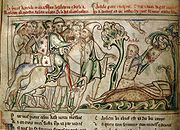
William de Brailes
William de Brailes was an English Early Gothic manuscript illuminator, presumably born in Brailes, Warwickshire. He signed two manuscripts, and apparently worked in Oxford, where he is documented from 1238 to 1252, owning property in Catte Street near the University Church of St Mary the Virgin,...
is shown with a clerical tonsure, but he was married, which suggests he had minor orders only. The manuscripts produced by Paris show few signs of collaboration, but art historians detect a School of St Albans' surviving after Paris's death, influenced by him.
In some manuscripts, a framed miniature occupies the upper half of the page, and in others they are "marginal" - unframed and occupying the bottom quarter (approximately) of the page. Tinted drawings were an established style well before Paris, and became especially popular in the first half of the 13th century. They were certainly much cheaper and quicker than fully painted illuminations.
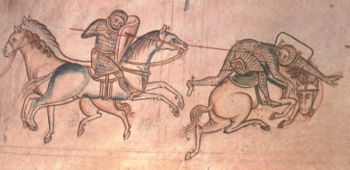
Paris as an historian
From 1235, the point at which WendoverRoger of Wendover
Roger of Wendover , probably a native of Wendover in Buckinghamshire, was an English chronicler of the 13th century.At an uncertain date he became a monk at St Albans Abbey; afterwards he was appointed prior of the cell of Belvoir, but he forfeited this dignity in the early years of Henry III,...
dropped his pen, Paris continued the history on the plan which his predecessors had followed. He derived much of his information from the letters of important people, which he sometimes inserts, but much more from conversation with the eye-witnesses of events. Among his informants were Richard, Earl of Cornwall and King Henry III
Henry III of England
Henry III was the son and successor of John as King of England, reigning for 56 years from 1216 until his death. His contemporaries knew him as Henry of Winchester. He was the first child king in England since the reign of Æthelred the Unready...
, with whom he appears to have been on intimate terms.
The king knew that Paris was writing a history, and wanted it to be as exact as possible. In 1257, in the course of a week's visit to St Albans, Henry kept the chronicler beside him night and day, "and guided my pen," says Paris, "with much goodwill and diligence." It is curious that the Chronica majora gives so unfavourable an account of the king's policy. Henry Richards Luard
Henry Richards Luard
Henry Richards Luard was a British medieval historian and antiquary.-Biography:Luard was the son of Henry Luard. He received his early education at Cheam. He graduated from Trinity College, Cambridge in 1847, and 1849 was elected to a Fellowship. He entered holy orders, and served as vicar of...
supposes that Paris never intended his work to be read in its present form. Many passages of the autograph have written next to them, the note offendiculum, which shows that the writer understood the danger which he ran. On the other hand, unexpurgated copies were made in Paris's lifetime. Although the offending passages are duly omitted or softened in his abridgment of his longer work, the Historia Anglorum (written about 1253), Paris's real feelings must have been an open secret. There is no ground for the old theory that he was an official historiographer.

Robert Grosseteste
Robert Grosseteste or Grossetete was an English statesman, scholastic philosopher, theologian and Bishop of Lincoln. He was born of humble parents at Stradbroke in Suffolk. A.C...
, while denouncing Grosseteste's scheme of monastic reform. Paris was a vehement supporter of the monastic orders against their rivals, the secular clergy and the mendicant friars. He was strongly opposed to the court and the foreign favourites. He thought the king inadequate as a statesman, although had some feeling for the man.
He attacked the court of Rome with surprising frankness, and also displayed considerable nationalism. His faults are often due to carelessness and narrow views, but he sometimes invents rhetorical speeches which are misleading as an account of the speaker's sentiments. In other cases he tampers with the documents which he inserts (as, for instance, with the text of Magna Carta
Magna Carta
Magna Carta is an English charter, originally issued in the year 1215 and reissued later in the 13th century in modified versions, which included the most direct challenges to the monarch's authority to date. The charter first passed into law in 1225...
). His chronology is, for a contemporary, inexact; and he occasionally inserts duplicate versions of the same incident in different places. Hence he must be rigorously checked when other authorities exist and used with caution where he is our sole informant. Nonetheless, he gives a more vivid impression of his age than any other English chronicler.
Studies of Matthew Paris
The relation of Matthew Paris's work to those of John de Celia (John of WallingfordJohn of Wallingford
John of Wallingford , also known as John de Cella, was Abbot of St Albans Abbey in the English county of Hertfordshire from 1195 to his death in 1214...
) and Roger of Wendover
Roger of Wendover
Roger of Wendover , probably a native of Wendover in Buckinghamshire, was an English chronicler of the 13th century.At an uncertain date he became a monk at St Albans Abbey; afterwards he was appointed prior of the cell of Belvoir, but he forfeited this dignity in the early years of Henry III,...
may be studied in Henry Richards Luard
Henry Richards Luard
Henry Richards Luard was a British medieval historian and antiquary.-Biography:Luard was the son of Henry Luard. He received his early education at Cheam. He graduated from Trinity College, Cambridge in 1847, and 1849 was elected to a Fellowship. He entered holy orders, and served as vicar of...
's edition of the Chronica majora (7 vols., Rolls series
Rolls Series
The Rolls Series, official title The Chronicles and Memorials of Great Britain and Ireland during the Middle Ages, is a major collection of British and Irish historical materials and primary sources, published in the second half of the 19th century. Some 255 volumes, representing 99 separate...
, 1872-1881), which contains valuable prefaces. The Historia Anglorum sive historia minor (1067-1253) has been edited by Frederic Madden
Frederic Madden
Sir Frederic Madden , was an English palaeographer.-Biography:Madden was the son of an officer of Irish extraction, he was born at Portsmouth. From his childhood he displayed a flair for linguistic and antiquarian studies...
(3 vols., Rolls series, 1866-1869).
Matthew Paris is sometimes confused with "Matthew of Westminster
Matthew of Westminster
Matthew of Westminster, long regarded as the author of the Flores Historiarum, is now thought never to have existed.The error was first discovered in 1826 by Francis Turner Palgrave, who said that Matthew was "a phantom who never existed," and later the truth of this statement was completely proved...
", the reputed author of the Flores historiarum
Flores Historiarum
The Flores Historiarum is a Latin chronicle dealing with English history from the creation to 1326 . It was compiled by various persons and quickly acquired contemporary popularity, for it was continued by many hands in many manuscript traditions...
edited by Luard (3 vols., Rolls series, 1890). This work, compiled by various hands, is an edition of Matthew Paris, with continuations extending to 1326.
He wrote a life of St Edmund of Canterbury
Edmund Rich
Edmund Rich was a 13th century Archbishop of Canterbury in England...
, which has been edited and translated by C.H. Lawrence (Oxford, 1996). He also wrote the Anglo-Norman
Anglo-Norman language
Anglo-Norman is the name traditionally given to the kind of Old Norman used in England and to some extent elsewhere in the British Isles during the Anglo-Norman period....
La Estoire de Seint Aedward le Rei (the History of Saint Edward the King), which survives in a beautifully illuminated manuscript version, Cambridge, Cambridge University Library MS. Ee.3.59. The text is edited in K.Y. Wallace, La Estoire de Seint Aedward le Rei, Anglo-Norman Text Society 41 (1983).
Paris House at St Albans High School for Girls
St Albans High School for Girls
St Albans High School is a private Church of England girls' day school founded in 1889 for girls aged 4 to 18, located in the city of St Albans, Hertfordshire with a primary school in the nearby village of Wheathampstead. It provides girls with good quality educational provision in all sections of...
is named after him.
Sources
(On manuscripts, and artistic style) Nigel Morgan, A Survey of Manuscripts Illuminated in the British Isles, Volume 4: Early Gothic Manuscripts, Part 1 1190-1250, Harvey Miller Ltd, London, 1982, ISBN 0-19-921026-8External links
- Images
- Stanford Digitized texts - Works by and about Paris, including Vaughan etc, in huge pdf files
- JSTOR review of Vaughan book
- Matthew Paris's Jerusalem pilgrim's travel guide: information, zoomable image British Library website
- Art Bulletin article on his maps;Imagined Pilgrimage in the Itinerary Maps of Matthew Paris. 12/1/1999 by Connolly, Daniel K
- Latin Chroniclers from the Eleventh to the Thirteenth Centuries:Matthew Paris from The Cambridge History of English and American LiteratureThe Cambridge History of English and American LiteratureThe Cambridge History of English and American Literature was originally published by Cambridge University Press in 1907–1921. The 18 volumes include 303 chapters and more than 11,000 pages edited and written by a worldwide panel of 171 leading scholars and thinkers of the early twentieth century...
, Volume I, 1907–21.

